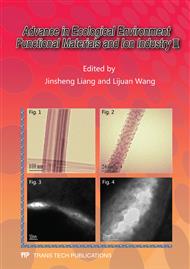[1]
F.M. Salih: Journal of Applied Microbiology 92 (2002) 920-926.
Google Scholar
[2]
N. Veronovski and M. Sfiligoj-Smole: Fibers and Polymers 11 (2010) 545-550.
DOI: 10.1007/s12221-010-0545-5
Google Scholar
[3]
R.M. Wang, B.Y. Wang and Y.F. He, et al.: Polymers for Advanced Technologies 21 (2010) 331-336.
Google Scholar
[4]
D. Grosso, M. Faustini and L. Nicole, et al.: Chemistry of Materials 22 (2010) 4406-4413.
Google Scholar
[5]
M. Montazer, R. Dastjerdi and S. Shahsavan: Colloids and Surfaces B-Biointerfaces 81 (2010) 32-41.
DOI: 10.1016/j.colsurfb.2010.06.023
Google Scholar
[6]
A.F. Shojaie, H.F. Moafi and M.A. Zanjanchi: Chemical Engineering Journal 166 (2011) 413-419.
Google Scholar
[7]
N.K. Allam, C.W. Yen and R.D. Near, et al.: Energy & Environmental Science 4 (2011) 2909-2914.
Google Scholar
[8]
N.K. Allam, H.A. Hamedani and H. Garmestani, et al.: Journal of Physical Chemistry C 115 (2011) 13480-13486.
Google Scholar
[9]
Y. Li, G.M. Wang and H.Y. Wang, et al.: Nano Letters 11 (2011) 3026-3033.
Google Scholar
[10]
T. Maeda, H. Nakao and H. Kito, et al.: Dyes and Pigments 90 (2011) 275-283.
Google Scholar
[11]
F.M.K. Tehrani, M. Rashidzadeh and A. Nemati, et al.: International Journal of Environmental Science and Technology 8 (2011) 545-552.
Google Scholar
[12]
X.D. Wang and J.A. Shi: Crystal Growth & Design 11 (2011) 949-954.
Google Scholar
[13]
G. Beobide, R. Prado and A. Marcaide, et al.: Solar Energy Materials and Solar Cells 94 (2010) 1081-1088.
DOI: 10.1016/j.solmat.2010.02.031
Google Scholar
[14]
R. Sarraf-Mamoory, B.K. Kaleji and S. Sanjabi: Reaction Kinetics Mechanisms and Catalysis 103 (2011) 289-298.
DOI: 10.1007/s11144-011-0327-y
Google Scholar
[15]
M. Ren, H.B. Yin and Z.Z. Lu, et al.: Powder Technology 204 (2010) 249-254.
Google Scholar
[16]
M. Ren, H.B. Yin and Z.Z. Lu, et al.: Transactions of Nonferrous Metals Society of China 19 (2009) 626-634.
Google Scholar
[17]
M. Ren, H.B. Yin and A.L. Wang, et al.: Applied Surface Science 254 (2008) 7314-7320.
Google Scholar
[18]
M. Ren, H.B. Yin and A.L. Wang, et al.: Materials Chemistry and Physics 103 (2007) 230-234.
Google Scholar


